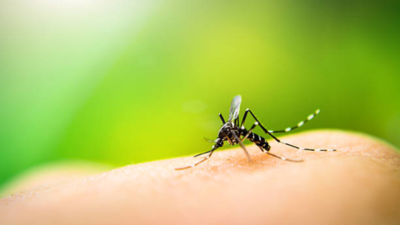- News
- lifestyle
- health-fitness
- health-news
- Dengue cases break records in the US: Signs and symptoms of the break-bone fever
Trending
Dengue cases break records in the US: Signs and symptoms of the break-bone fever
Dengue cases surge in the US due to climate change, with intense outbreaks in Brazil and Peru. Lack of specific antiviral treatment underscores the importance of prevention through mosquito control. 'Break-bone fever' nickname illustrates the severe joint pain experienced, highlighting the need for public health vigilance.

Health officials in the US have warned doctors to be careful about dengue cases as the number of the mosquito borne disease has broken calendar-year records. Dengue remains less common in the continental United States, but in the 50 states so far this year there have been three times more cases than at the same point last year. Most were infections that travelers got abroad, and officials note there is no evidence of a current outbreak.But they also warn that local mosquitos pose a threat, AP reported.
Dengue is spreading across the globe
The recent surge of dengue cases in the US is due to climate change, experts have said. Dengue is caused by a virus spread by a type of warm weather mosquito. There are four types of dengue virus, simply known as 1, 2, 3 and 4. When someone is first infected, their body builds antibodies against that type for life. If they get infected with another type of dengue, the antibodies from the first infection may fail to neutralize the second type - and actually can help the virus enter immune cells and replicate.
Why is dengue called break-bone fever
Dengue is often referred to as "break-bone fever" due to the severe muscle and joint pain it causes, which can feel like bones are breaking. This nickname vividly describes the intense pain experienced by those infected with the dengue virus, a mosquito-borne pathogen transmitted primarily by Aedes mosquitoes.
Dengue fever can range from mild to severe. In its more severe forms, such as dengue hemorrhagic fever (DHF) or dengue shock syndrome (DSS), the disease can lead to bleeding, blood plasma leakage, and potentially life-threatening complications. Despite the intense pain and potential complications, most cases of dengue fever can be managed with supportive care, including hydration and pain relief, though prevention through mosquito control and avoiding bites remains crucial.
Are there any medicines available against dengue infection?
As of now, there is no specific antiviral medicine to treat dengue infection. Treatment primarily focuses on supportive care to manage symptoms. This includes maintaining hydration, using pain relievers like acetaminophen, and monitoring for signs of severe complications. In severe cases, hospitalization may be required for intravenous fluids and medical monitoring. Prevention is key, involving mosquito control measures and vaccination in some regions.
Across the world, more than 6.6 million infections were reported by about 80 countries last year. In the first four months of this year, 7.9 million cases and 4,000 deaths have been reported, according to the World Health Organization. It's been particularly intense in the Americas, including in Brazil and Peru.
In the United States, the numbers have been far more modest - about 3,000 cases last year in U.S. states and territories. But it was the worst in a decade, and included more infections that occurred locally, courtesy of native mosquitoes. Most were in Puerto Rico, but about 180 were in three U.S. states - Florida, Texas and California.
So far this year, there have been nearly 1,500 locally-acquired U.S. cases, nearly all of them in Puerto Rico.
(With inputs from AP)
Dengue is spreading across the globe
The recent surge of dengue cases in the US is due to climate change, experts have said. Dengue is caused by a virus spread by a type of warm weather mosquito. There are four types of dengue virus, simply known as 1, 2, 3 and 4. When someone is first infected, their body builds antibodies against that type for life. If they get infected with another type of dengue, the antibodies from the first infection may fail to neutralize the second type - and actually can help the virus enter immune cells and replicate.
Why is dengue called break-bone fever
The term "break-bone fever" was first coined in the 18th century during outbreaks in Asia, Africa, and North America. Patients reported excruciating pain in their bones, muscles, and joints, along with high fever, headaches, and rashes. These symptoms can be debilitating, making even simple movements extremely painful. The severe joint pain and muscle aches are hallmarks of the disease and contribute significantly to the discomfort and suffering of those affected.
Dengue fever can range from mild to severe. In its more severe forms, such as dengue hemorrhagic fever (DHF) or dengue shock syndrome (DSS), the disease can lead to bleeding, blood plasma leakage, and potentially life-threatening complications. Despite the intense pain and potential complications, most cases of dengue fever can be managed with supportive care, including hydration and pain relief, though prevention through mosquito control and avoiding bites remains crucial.
Are there any medicines available against dengue infection?
Across the world, more than 6.6 million infections were reported by about 80 countries last year. In the first four months of this year, 7.9 million cases and 4,000 deaths have been reported, according to the World Health Organization. It's been particularly intense in the Americas, including in Brazil and Peru.
In the United States, the numbers have been far more modest - about 3,000 cases last year in U.S. states and territories. But it was the worst in a decade, and included more infections that occurred locally, courtesy of native mosquitoes. Most were in Puerto Rico, but about 180 were in three U.S. states - Florida, Texas and California.
Good habits that can help one stay away from tobacco addiction
So far this year, there have been nearly 1,500 locally-acquired U.S. cases, nearly all of them in Puerto Rico.
(With inputs from AP)
End of Article
FOLLOW US ON SOCIAL MEDIA









